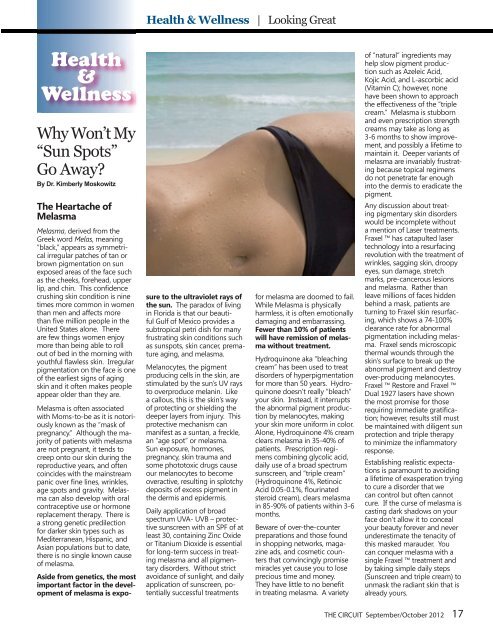View This Issue - Panama City Beach Chamber of Commerce
View This Issue - Panama City Beach Chamber of Commerce
View This Issue - Panama City Beach Chamber of Commerce
Create successful ePaper yourself
Turn your PDF publications into a flip-book with our unique Google optimized e-Paper software.
Health & Wellness | Looking Great<br />
Health<br />
&<br />
Wellness<br />
Why Won’t My<br />
“Sun Spots”<br />
Go Away?<br />
By Dr. Kimberly Moskowitz<br />
The Heartache <strong>of</strong><br />
Melasma<br />
Melasma, derived from the<br />
Greek word Melas, meaning<br />
“black,” appears as symmetrical<br />
irregular patches <strong>of</strong> tan or<br />
brown pigmentation on sun<br />
exposed areas <strong>of</strong> the face such<br />
as the cheeks, forehead, upper<br />
lip, and chin. <strong>This</strong> confidence<br />
crushing skin condition is nine<br />
times more common in women<br />
than men and affects more<br />
than five million people in the<br />
United States alone. There<br />
are few things women enjoy<br />
more than being able to roll<br />
out <strong>of</strong> bed in the morning with<br />
youthful flawless skin. Irregular<br />
pigmentation on the face is one<br />
<strong>of</strong> the earliest signs <strong>of</strong> aging<br />
skin and it <strong>of</strong>ten makes people<br />
appear older than they are.<br />
Melasma is <strong>of</strong>ten associated<br />
with Moms-to-be as it is notoriously<br />
known as the “mask <strong>of</strong><br />
pregnancy.” Although the majority<br />
<strong>of</strong> patients with melasma<br />
are not pregnant, it tends to<br />
creep onto our skin during the<br />
reproductive years, and <strong>of</strong>ten<br />
coincides with the mainstream<br />
panic over fine lines, wrinkles,<br />
age spots and gravity. Melasma<br />
can also develop with oral<br />
contraceptive use or hormone<br />
replacement therapy. There is<br />
a strong genetic predilection<br />
for darker skin types such as<br />
Mediterranean, Hispanic, and<br />
Asian populations but to date,<br />
there is no single known cause<br />
<strong>of</strong> melasma.<br />
Aside from genetics, the most<br />
important factor in the development<br />
<strong>of</strong> melasma is exposure<br />
to the ultraviolet rays <strong>of</strong><br />
the sun. The paradox <strong>of</strong> living<br />
in Florida is that our beautiful<br />
Gulf <strong>of</strong> Mexico provides a<br />
subtropical petri dish for many<br />
frustrating skin conditions such<br />
as sunspots, skin cancer, premature<br />
aging, and melasma.<br />
Melanocytes, the pigment<br />
producing cells in the skin, are<br />
stimulated by the sun’s UV rays<br />
to overproduce melanin. Like<br />
a callous, this is the skin’s way<br />
<strong>of</strong> protecting or shielding the<br />
deeper layers from injury. <strong>This</strong><br />
protective mechanism can<br />
manifest as a suntan, a freckle,<br />
an “age spot” or melasma.<br />
Sun exposure, hormones,<br />
pregnancy, skin trauma and<br />
some phototoxic drugs cause<br />
our melanocytes to become<br />
overactive, resulting in splotchy<br />
deposits <strong>of</strong> excess pigment in<br />
the dermis and epidermis.<br />
Daily application <strong>of</strong> broad<br />
spectrum UVA- UVB – protective<br />
sunscreen with an SPF <strong>of</strong> at<br />
least 30, containing Zinc Oxide<br />
or Titanium Dioxide is essential<br />
for long-term success in treating<br />
melasma and all pigmentary<br />
disorders. Without strict<br />
avoidance <strong>of</strong> sunlight, and daily<br />
application <strong>of</strong> sunscreen, potentially<br />
successful treatments<br />
for melasma are doomed to fail.<br />
While Melasma is physically<br />
harmless, it is <strong>of</strong>ten emotionally<br />
damaging and embarrassing.<br />
Fewer than 10% <strong>of</strong> patients<br />
will have remission <strong>of</strong> melasma<br />
without treatment.<br />
Hydroquinone aka “bleaching<br />
cream” has been used to treat<br />
disorders <strong>of</strong> hyperpigmentation<br />
for more than 50 years. Hydroquinone<br />
doesn’t really “bleach”<br />
your skin. Instead, it interrupts<br />
the abnormal pigment production<br />
by melanocytes, making<br />
your skin more uniform in color.<br />
Alone, Hydroquinone 4% cream<br />
clears melasma in 35-40% <strong>of</strong><br />
patients. Prescription regimens<br />
combining glycolic acid,<br />
daily use <strong>of</strong> a broad spectrum<br />
sunscreen, and “triple cream”<br />
(Hydroquinone 4%, Retinoic<br />
Acid 0.05-0.1%, flourinated<br />
steroid cream), clears melasma<br />
in 85-90% <strong>of</strong> patients within 3-6<br />
months.<br />
Beware <strong>of</strong> over-the-counter<br />
preparations and those found<br />
in shopping networks, magazine<br />
ads, and cosmetic counters<br />
that convincingly promise<br />
miracles yet cause you to lose<br />
precious time and money.<br />
They have little to no benefit<br />
in treating melasma. A variety<br />
<strong>of</strong> “natural” ingredients may<br />
help slow pigment production<br />
such as Azeleic Acid,<br />
Kojic Acid, and L-ascorbic acid<br />
(Vitamin C); however, none<br />
have been shown to approach<br />
the effectiveness <strong>of</strong> the “triple<br />
cream.” Melasma is stubborn<br />
and even prescription strength<br />
creams may take as long as<br />
3-6 months to show improvement,<br />
and possibly a lifetime to<br />
maintain it. Deeper variants <strong>of</strong><br />
melasma are invariably frustrating<br />
because topical regimens<br />
do not penetrate far enough<br />
into the dermis to eradicate the<br />
pigment.<br />
Any discussion about treating<br />
pigmentary skin disorders<br />
would be incomplete without<br />
a mention <strong>of</strong> Laser treatments.<br />
Fraxel has catapulted laser<br />
technology into a resurfacing<br />
revolution with the treatment <strong>of</strong><br />
wrinkles, sagging skin, droopy<br />
eyes, sun damage, stretch<br />
marks, pre-cancerous lesions<br />
and melasma. Rather than<br />
leave millions <strong>of</strong> faces hidden<br />
behind a mask, patients are<br />
turning to Fraxel skin resurfacing,<br />
which shows a 74-100%<br />
clearance rate for abnormal<br />
pigmentation including melasma.<br />
Fraxel sends microscopic<br />
thermal wounds through the<br />
skin’s surface to break up the<br />
abnormal pigment and destroy<br />
over-producing melanocytes.<br />
Fraxel Restore and Fraxel <br />
Dual 1927 lasers have shown<br />
the most promise for those<br />
requiring immediate gratification;<br />
however, results still must<br />
be maintained with diligent sun<br />
protection and triple therapy<br />
to minimize the inflammatory<br />
response.<br />
Establishing realistic expectations<br />
is paramount to avoiding<br />
a lifetime <strong>of</strong> exasperation trying<br />
to cure a disorder that we<br />
can control but <strong>of</strong>ten cannot<br />
cure. If the curse <strong>of</strong> melasma is<br />
casting dark shadows on your<br />
face don’t allow it to conceal<br />
your beauty forever and never<br />
underestimate the tenacity <strong>of</strong><br />
this masked marauder. You<br />
can conquer melasma with a<br />
single Fraxel treatment and<br />
by taking simple daily steps<br />
(Sunscreen and triple cream) to<br />
unmask the radiant skin that is<br />
already yours.<br />
THE CIRCUIT September/October 2012 17
















